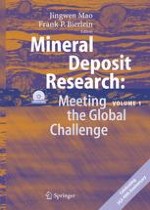2005 | OriginalPaper | Buchkapitel
Transport and deposition of selenium in felsic volcanic-hosted massive sulfide deposits of the Finlayson Lake District, Yukon Territory, Canada
verfasst von : D. Layton-Matthews, S. D. Scott, J. M. Peter, M. I. Leybourne
Erschienen in: Mineral Deposit Research: Meeting the Global Challenge
Verlag: Springer Berlin Heidelberg
Aktivieren Sie unsere intelligente Suche, um passende Fachinhalte oder Patente zu finden.
Wählen Sie Textabschnitte aus um mit Künstlicher Intelligenz passenden Patente zu finden. powered by
Markieren Sie Textabschnitte, um KI-gestützt weitere passende Inhalte zu finden. powered by
The mobility and hydrothermal transport of selenium are a function of the fluid pH, fO
2
and temperature. At high temperatures (>200°C) and relatively acidic (pH <6) conditions, H
2
Se is the dominant aqueous species. At ambient seafloor temperatures, reduced forms of selenium are relatively immobile, but the element becomes increasingly mobile under oxidized conditions. Deposition of selenium from a hydrothermal fluid results when relatively hot, acidic, reduced hydrothermal fluid mixes with cold (1-10°C), oxidized ambient seawater. The selenium content of the precipitating sulfide is controlled by the reaction: MtSe
2
+ H
2
S
(aq)
=MtS
2
+H
2
Se
(aq)
, where Mt is a transition metal, and therefore H
2
Se/H
2
S approximates the Se/S of the fluid at the time of sulfide precipitation. However, in modern and ancient volcanic-hosted massive sulfide (VHMS) systems the final residence site of transition metals (and Se), or their redistribution, is ultimately a function of the solubility product (log Q/K) and temperature of precipitation of the sulfide minerals, which produce metal zoning in sulfide mounds as a result of hydrothermal fluid interaction/ dissolution with previously precipitated sulfide minerals (a.k.a., zone refining). Observations and data from ancient VMS deposits in the Finlayson Lake District (FLD), Yukon, Canada show a strong positive correlation between high-temperature (<300°C), copper-rich sulfide assemblages at the base of VHMS and the selenium content of all sulfide minerals. Thermodynamic calculations for selenide and sulfide minerals indicate significantly higher temperatures and lower solubility indices for the formation of selenide versus sulfide pairs, which is consistent with petrographic observations and can explain the distribution of selenium in zone-refined VMS deposits.
